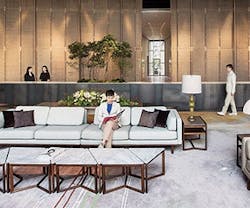International Design Influencing Global Brands
In a digital world that is seemingly smaller than ever before, globalization often means homogenization. But, for global companies entering new markets, design can help balance brand identity with local culture. Three design leaders from international firms that recently won IIDA competitions explain below how they design spaces that honor place, history, and context in the face of globalization.
Capturing Uniqueness
While globalization and technology may increase access to good design, it can also mean that trends spread quickly across continents, creating uniformity where there was once variety.
“Technology opens up the world, but because things are so easily obtainable, as designers, we are in trouble,” said Johnny Li, Associate IIDA, managing director of LI&Co. Li’s Hong Kong and Boston twin-cities-based design studio takes on projects around the globe, including in the U.S., Asia, and the Middle East. LI&Co was named a winner of the IIDA 2016 Best of Asia Pacific Design Awards competition for L’ECOLE Van Cleef & Arpels—The Nomadic School of Jewelry and Watchmaking in Hong Kong.
“The conveniences of technology and globalization are fantastic, but the challenges are how to overcome these influences and deliver one-of-a-kind design,” he continued. “That touch of uniqueness is crucial to what we do when designing for high-end lifestyle brands.”
Designer Todd-Avery Lenahan, founder of TAL Studio, a winner of the 2015 Best Interiors of Latin America and the Caribbean Competition for Malliouhana—an Auberge Resort in Meads Bay, Anguilla—echoed Li’s concerns about globalization’s effect on design. “In hospitality design, our clients are very much respectful of culture and the regional, social, and political context of where the project is based. Our clients want to honor the unique attributes of a place and its people. But we are in the minority. Other developers build hotels around the world and there’s an increasing sameness. Homogenization makes projects more efficient, but you risk losing important cultural differentiators.”
Avoiding Cliché in International Design
While homogeny can destroy what makes a design unique, avoiding stereotypes is critical to creating a space that speaks to local culture without feeling cartoonish or, even worse, patronizing.
“One mistake designers make when they work in a different culture is that they assume the cliché is what things are, but you must delve deeper,”
Li noted. “For L’ECOLE Van Cleef & Arpels, we incorporated elements that captured the spirit of Hong Kong.” He was able to stay true to the DNA of the jewelry and watchmaking school’s Parisian brand while infusing Hong Kong elements by utilizing bamboo in the design.
“Bamboo is a symbol of virtue in the Chinese culture,” Li explained. “It reflects people’s souls and emotions. Bamboo signifies the strength in defiance, yet adaptability in the natural flow of harmony. Bamboo details were infused in many different ways as part of the structural elements, including mixed bamboo fiber and wool woven rugs, bamboo mesh screens, bamboo motif, etc. Even lectures at the school were programmed with the exploration of bamboo structure and the technique in jewelry making.”
A Responsibility to Local Culture and Craft
For Lenahan, TAL Studio finds that leveraging technology and local resources not only brings culture and context into projects, but it’s also the responsible and sustainable way to execute. For example, TAL Studio will work with a liaison to facilitate connections with local art, materials, and construction when working abroad. The goal, Lenahan explained, is to dial into great talent and resources in a region.
Mark Landini, creative director of Landini and Associates, a Sydney, Australia-based firm and 2016 Global Excellence Awards winner for T2 Shoreditch in London, boasts a portfolio of work that is 70-percent international. “We work in multiple ways—sometimes with a client’s design team, other times with local architects and design teams. It doesn’t really matter so long as we have empathy, a mutual respect, and eat together a lot. We rarely import finishes or furniture as that would be wasteful, and we would rather collaborate and create the solution based on an iterative process that we lead.”
According to Lenahan, staying true to the local spirit of a design project also appeals to travelers who want to experience the culture, which perhaps points to an anecdote for the homogenizing effects of globalization. “Discerning travelers have an appreciation for craft and culture,” he said. “They are looking for that. It’s why they choose to stay at one hotel over another. Luxury used to be defined by a commoditized set of elements, but today guests perceive luxury in nuanced elements. People are looking for authentic experiences.”
For more information about IIDA international design competitions, visit iida.org/competitions.
Photography courtesy of LI&Co.
